ABSTRACT
This article aims at discussing the National System of Science and Technology (NSST) as well as the National Research and Innovation Agency (BRIN) to particularly strengthen Research and Development (R&D) in Indonesia. The National System of Science and Technology has among other objectives towards promoting, developing, strengthening, and improving R&D inventions and innovations. Meanwhile, the BRIN aims at integrating research and development in a sustainable manner. The former is organized through respective institutions under coordination of government, while the latter is implemented by integrating relevant institutions. Both institutions are essential in national development planning based-network patterns of science and technology as well as integrated inventions and innovations. The integration, as not to be interpreted as a fusion, is necessary to particularly avoid budget inefficiencies and overlap R&D activities that become urgent for the utilization of inventions and innovations within the BRIN of the country.
Keywords: science, technology, research, invention, innovation, system, Indonesia
INTRODUCTION
Background
The Government of Indonesia (GoI) has issued two essential regulations related to Research and Development (R&D) in the country. They are Law Number 11/2019 on National System of Science and Technology (NSST) (GoI, 2019) and Presidential Regulation Number 33/2021 on Badan Riset dan Inovasi Nasional, BRIN, (National Research and Innovation Agency) (GoI, 2021). These regulations were promulgated on 13 August 2019 and 28 April 2021, respectively.
Law Number 11/2019 necessarily regulates the national system of science and technology as the basis for formulating development policies in order to strengthen the carrying capacity of science and technology in achieving the goals of the state as well as to increase the competitiveness and independence of the nation. Meanwhile, Presidential Regulation Number 33/2021 essentially stipulates Law Number 22/2019 (article 48), in which it establishes the BRIN to carry out R&D for inventions and innovations in an integrated manner.
Apart from implementing Law Number 11/2019, Presidential Regulation Number 33/2021 is also in line with Law Number 11/2020 on Job Creation, particularly article 121 (GoI, 2020). In other words, this Presidential Regulation is not only to simplify the NSST, but also to generate R&D activities through the BRIN. At least, this agency has three directions (BPPT.go.id. 2021), namely: (1) Consolidating science and technology resources (human, infrastructure, and budget) to increase critical mass, capacity, and research competence of Indonesia; (2) Producing inventions and innovations as the main basis for Advanced Indonesia 2045[1]; and (3) Creating a research ecosystem according to global standards that are inclusive and collaborative for all respective parties (government, academics, industry, and community).
Objective
The objective of this article is to discuss the NSST as well as the establishment of the BRIN to particularly strengthen R&D in Indonesia. It is followed by conclusion and recommendation in accordance with the implementation of both institutions in the country.
NATIONAL SYSTEM OF SCIENCE AND TECHNOLOGY
Rationale
Essentially, the NSST is defined as a pattern of relationships-based planned, directed, and measurable linkage, as well as the passage of institutional elements and resources. It is to facilitate a collected network of science and technology as wholly unified to support the implementation of science and technology as a scientific basis in formulation and determination of national development policies.
The NSST has four objectives. They are: (1) Promoting and improving the quality of research and development of science and technology based-inventions and innovations; (2) Increasing the intensity and quality of interactions, partnerships, and synergies between elements of science and technology stakeholders; (3) Developing the use of science and technology for sustainable national development, quality of life, and community welfare; and (4) Strengthening independence, competitiveness, and attractiveness in the context of advancing the nation’s civilization through international relations.
To realize the objectives of the NSST, the master plan is prepared as a reference for the national long, medium, and annual terms and serves as the basis for preparation of the national development plan. This master plan is developed by the government in coordination with relevant stakeholders.
The master plan includes at least: (1) Improving the quality of human life, people’s welfare, independence, national competitiveness, and national civilization; (2) Enhancing natural, science, and technology resources; (3) Developing science and technology; (4) Rising sociocultural science and technology as well as local wisdom that grows in the community; (5) Progressing socioeconomic development of the region; (6) Advancing the development of science and technology; and (7) Expanding the strategic environment. Moreover, the issue and period of master plan are summarized in Table 1.
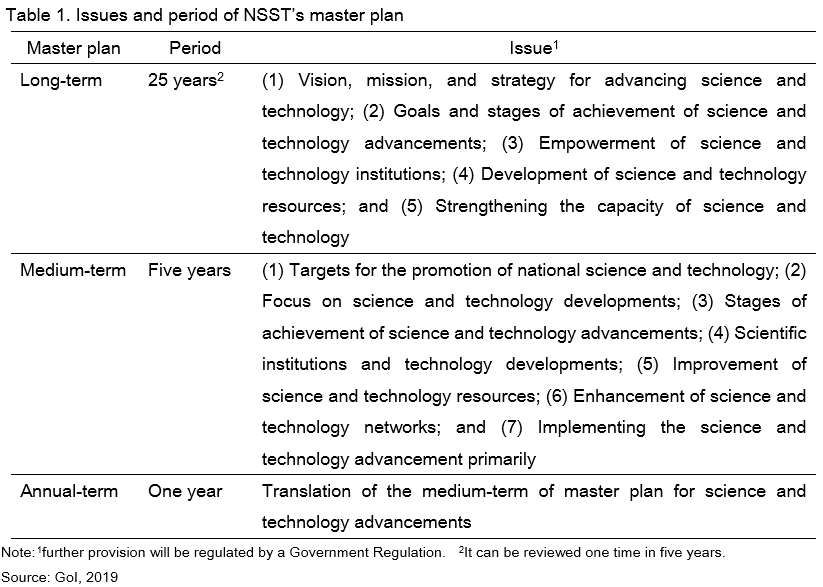
Implementation
The NSST can be carried out by individual, group, business entities, government or private institutions, and/or universities. Those are implemented through R&D under the coordination of the government.
R&Ds are conducted to: (1) Strengthen the mastery of basic and applied sciences, including social sciences used to create and/or to develop science and technology, and can also be a solution to development problems; and (2) Improve the welfare of community and advance civilization. Hence, the results of R&D must be published and disseminated.
The essence of the NSST is invention and innovation. Therefore, those are developed towards: (1) Becoming a solution to national problems; (2) Combining technical, functional, business, sociocultural, and aesthetic viewpoints and contexts; and (3) Generating added value from products and/or production processes for the welfare of community. Inventions and innovations can be derived from: (1) Basic and applied research and development; (2) Technology transfer, (3) Reverse engineering; (4) Technology inter-mediation; (5) Diffusion of science and technology; and (6) Technology commercialization.
Institutionally, the NSST consists of: (1) R&D institutions; (2) Assessment and implementation agency; (3) Universities; (4) Business entities; and (5) Supporting institutions. The purpose of R&D institutions is particularly to foster the ability to advance science and technology which are responsible for producing inventions and exploring their potential utilization. Other requirements of the NSST are summarized in Table 2. It entails the aspects of protection, funding, network, supervision, responsibility, and sanctions.
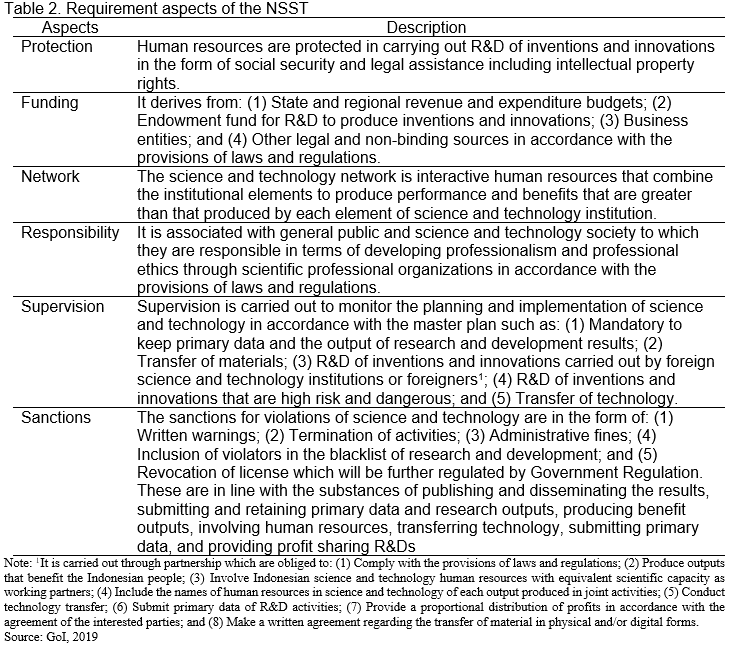
On 22 July 2021, Circular Ministerial Letter of Administrative and Bureaucratic Reform Number B/295/M.SM.02.03/2021 issued Transfer of Researchers from R&D institutions of Ministry/Agency(s) to the BRIN. It is sated that BRIN currently coordinates with 48 Ministry/Agency(s) by classifying the execution of the integration of R&D institutions into BRIN through three categories, namely: (1) Total integration of R&D; (2) Partial integration of related work units; and (3) Conversion of R&D institutions to different nomenclatures, tasks, and functions. In this case, BRIN will receive programs, human resources, and related assets.
To ensure career certainty of R&D human resources as the impact of the intended national integration policy, it will precede the following steps:
- BRIN carries out mapping the needs for position of R&D human resources after program transfer that can be filled by research functional officers from Ministry/Agency(s).
- BRIN coordinates with the R&D institutions of Ministry/Agency(s) to determine the R&D human resources who will be transferred to BRIN, or who will continue to work at the Ministry/Agency(s) for certain reasons.
- It is implemented that R&D institutions at Ministry/Agency(s) deploy R&D human resources and coordinate regularly with BRIN.
- For R&D human resources who do not transfer to BRIN after points 1 and point 2 above have been carried out, they can switch to other functional positions at the Ministry/Agency(s) in accordance with the provisions of the legislation
The entire processes as mentioned above should be completed before 31 December 2022 and during this transitional period, active R&D human resources in Ministry/Agency(s) are able to remain in their positions.
NATIONAL RESEARCH AND INNOVATION AGENCY (BRIN)
Substance
The National Research and Innovation Agency (BRIN) is a government institution established under and responsible directly to the President of the Republic of Indonesia that carries out R&D of integrated inventions and innovations. The institution is also formed by the local government called the Regional Research and Innovation Agency (Badan Riset dan Inovasi Daerah, BRIDA).
This agency is an offshoot of the NSST as mandated by the Law Number 11/2019 (GoI, 2019). It particularly includes: (1) Obliging the development of inventions and innovations (Article 34); (2) Protecting the use and intellectual property rights as a results of national inventions and innovations (Article 35); (3) Using the results of national inventions and innovations; (4) Assuring the utilization of R&D of inventions and innovations for national development; and (5) Forming the science and technology institutions, namely R&D institutions, application and assessment institutions, universities, business entities; and supporting institutions.
Policy direction and target
The policy direction and target of the BRIN is shown in Table 3. It encompasses three-directions and seven-target policies.
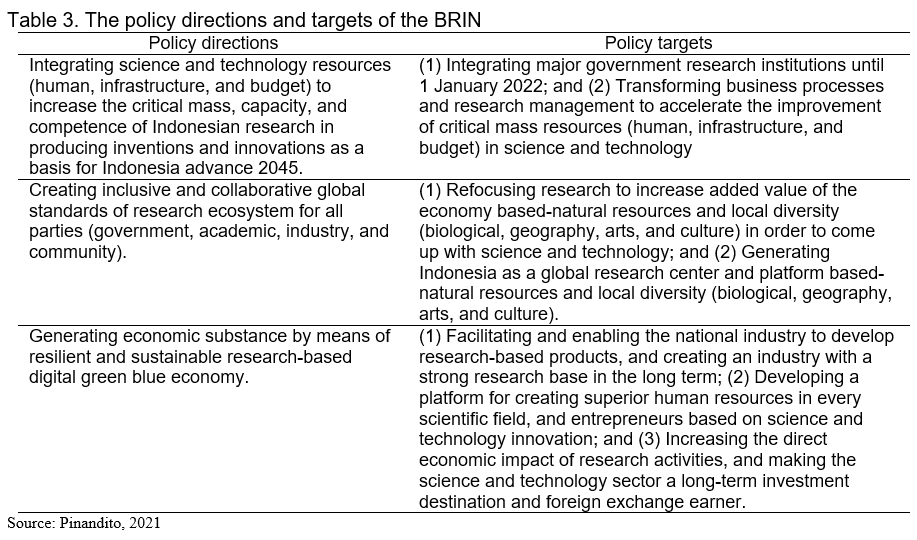
Institutionally, the BRIN corresponds to 28 non-ministerial government agencies and 91 non-structural agencies. It includes the Indonesian Institute of Sciences (LIPI), the Agency for the Assessment and Application of Technology (BPPT), the National Nuclear Energy Agency (BATAN), and the National Institute of Aeronautics and Space (LAPAN). Therefore, it is consequently required particular institutional management to develop this agency in a sustainable manner. For R&D within the ministry/agency(s), there are particular general and optional policies as presented in Table 4.
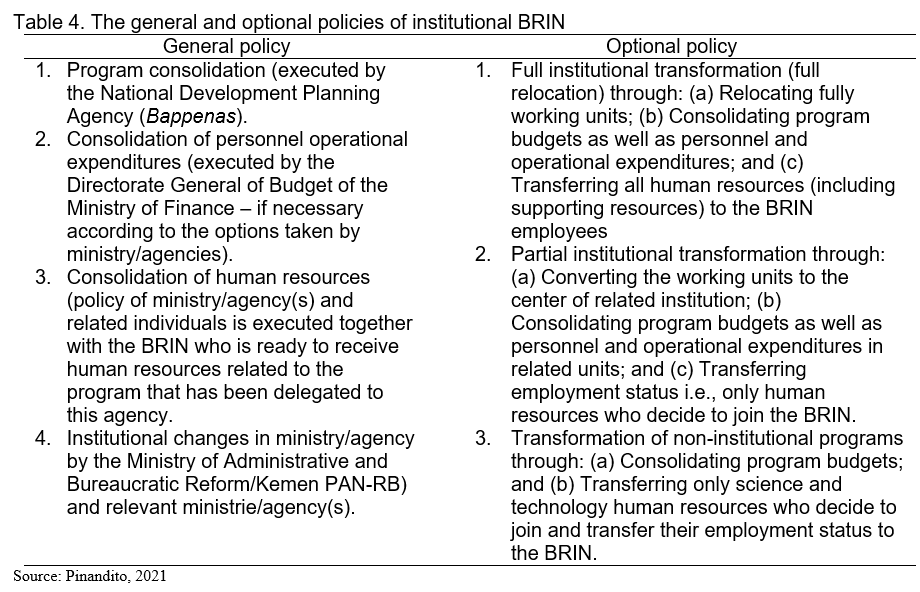
Major challenges
Optional policies as described in Table 4 are in line with the recommendation of Prataksita (2021) of Knowledge Sector Initiative that the BRIN should take “soft consolidation” or non-structural consolidation to empower BRIN on the coordination and supervision of R&D program and budget. However, in practice BRIN take the option to fully integrate all agencies related to R&D in the country which cover institution, human resource, R&D infrastructures, program and budget.
In implementing the above mentioned, there are some challenges which will hinder the smooth implementation of R&D policies and programs as the following:
1. BRIN becomes a super body coordinating research and innovation policies in the country. This raises concern on the span of control of the agency to be effectively managed personal, physical asset, program and budget.
2. There is a question on how line ministries get access to the research results produced by the BRIN based on the need of the corresponding ministries. Related to this issue, there is a proposal that BRIN may allow selected scientist to be seconded to the line ministries in accordance with their needs.
3. From the scientist point of view, it creates uncertainty on their career path and whether this transformation will be sustained with the changes on the administration regime in the future.
CONCLUSION AND RECOMMENDATIONS
The Law Number 11/2019 on National System of Science and Technology provides a solid basis for science and technology to play a role in national development planning. The process of implementing science and technology must be oriented towards supporting economic growth.
In accordance with the Law Number 11/2019 which is supported by Law Number 11/2020 on Job Creation, it is established the National Research and Innovation Agency as mandated in the Presidential Regulation Number 33/2021. The National Research and Innovation Agency carries out inventions and innovations towards R&D activities more integrated nationally.
Currently, the existence of the National Research and Innovation Agency is being consolidated. Nevertheless, it is realized that the consolidation process within this agency requires time and resources since it involves various institutions under the ministry/agency(s).
The keyword of the BRIN is integrated[2]. In other words, it is required that an operational legal basis to carry out R&D as well as inventions and innovations in an integrated manner and clarity of relations of science and technology implementing institutions related to ministry/agency(s). It is also required that the research and innovation stakeholders represent key local actors from the government, research and scientific institutions, companies and citizens to engage in bottom-up collaborative processes in innovation policy and challenge the traditional top-down policy making process (Quadruple Helix Model).
It is underlined that integration should not be interpreted as a fusion. The integration is necessary to particularly avoid budget inefficiencies and overlap R&D activities that become urgent for the utilization of inventions and innovations within the BRIN in Indonesia. There are some challenges for the BRIN to smoothly manage the transformation related to span of control, relation with the line ministries in delivering research results, and sustainability of this transformation with the possible change on administration regime.
REFERENCES
Bappenas. 2018. Indonesian Vision 2045. Presented at Business Breakfast Forum Financial Club, Jakarta 28 September 2018. Badan Perencanaan Pembangunan Nasional (National Development Planning Agency). Jakarta.
GoI. 2019. Undang-Undang Republik Indonesia Nomor 11 Tahun 2019 tentang Sistem Nasional Ilmu Pengetahuan dan Teknologi (Indonesia’s Law Number 11/2019 on National System of Science and Technology). Government of the Republic of Indonesia. Jakarta.
GoI. 2020. Undang-Undang Nomor 11 Tahun 2020 tentang Cipta Kerja (Law Number 11/2020 on Job Creation). Government of the Republic of Indonesia. Jakarta.
GoI. 2021. Peraturan Presiden Republik Indonesia Nomor 33 Tahun 2021 tentang Badan Riset dan Inovasi Nasional (Presidential Regulation Number 33/2021 on National Research and Innovation Agency). Government of the Republic of Indonesia. Jakarta.
MoABR. 2021. Surat Edaran Menteri Pendayagunaan Aparatur Negara dan Reformasi Birokrasi Republik Indonesia Number 3/2021 tentang Pengalihan Peneliti pada Lembaga Penelitian dan Pengembangan Kementerian/Lembaga ke Badan Riset dan Inovasi Nasional/BRIN (Circular Ministerial Letter of Administrative and Bureaucratic Reform Number 3/2021 concerning Transfer of Researchers from Research and Development Institutes of Ministries/Institutions to the National Research and Innovation Agency/BRIN ). Indonesian Ministry of Administrative and Bureaucratic Reform. Jakarta.
Pinandito, M. 2021. Kelembagaan Litbang K/L Pasca BRIN (Institutional Research and Development Agency of Ministry/Institutions Post BRIN). National Research and Innovation Agency. Jakarta.
Prataksita, N. 2021. Konsolidasi Pengorganisasian Litbangkirap untuk Mewujudkan Penguatan Penyelenggaan Litbangjirap dan Inovasi (Consolidation on the Management of Reseach and Innovation to Strengthen NSST). Cobsulting Services Contract: CSA-2011026. Kowledge Sector Initiative. Jakarta
[1] Indonesia has a vision towards 2045 based-development pillars of human development and mastery of science and technology, sustainable economic development, equitable development, and national resilience and governance (Bappenas, 2018)
[2] Integrated is an effort to direct and synergize, among others, in the preparation of plans, programs, budgets, and resources of science and technology in the fields of research and development to produce inventions and innovations as a scientific basis in the formulation and determination of national development policies (GoI, 2019)
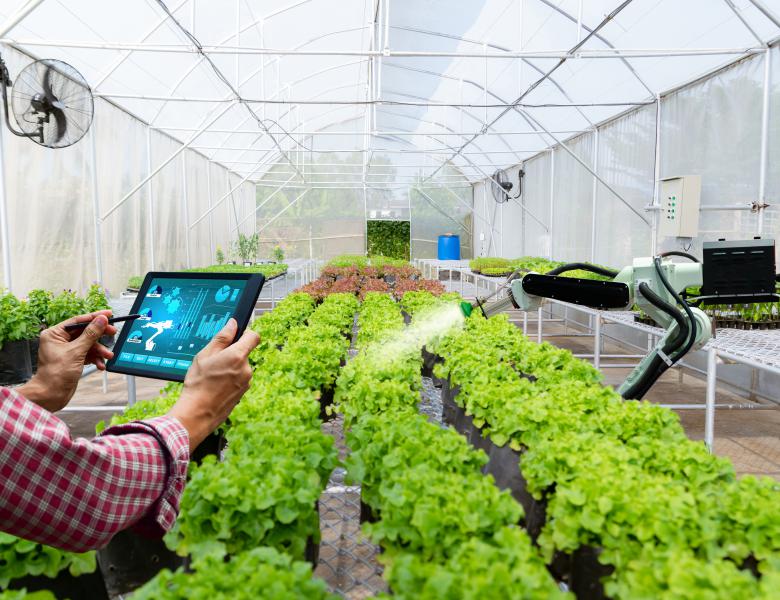




The Establishment of National Research and Innovation Agency as Mandated by the Law Number 11/2019 on National System of Science and Technology in Indonesia
ABSTRACT
This article aims at discussing the National System of Science and Technology (NSST) as well as the National Research and Innovation Agency (BRIN) to particularly strengthen Research and Development (R&D) in Indonesia. The National System of Science and Technology has among other objectives towards promoting, developing, strengthening, and improving R&D inventions and innovations. Meanwhile, the BRIN aims at integrating research and development in a sustainable manner. The former is organized through respective institutions under coordination of government, while the latter is implemented by integrating relevant institutions. Both institutions are essential in national development planning based-network patterns of science and technology as well as integrated inventions and innovations. The integration, as not to be interpreted as a fusion, is necessary to particularly avoid budget inefficiencies and overlap R&D activities that become urgent for the utilization of inventions and innovations within the BRIN of the country.
Keywords: science, technology, research, invention, innovation, system, Indonesia
INTRODUCTION
Background
The Government of Indonesia (GoI) has issued two essential regulations related to Research and Development (R&D) in the country. They are Law Number 11/2019 on National System of Science and Technology (NSST) (GoI, 2019) and Presidential Regulation Number 33/2021 on Badan Riset dan Inovasi Nasional, BRIN, (National Research and Innovation Agency) (GoI, 2021). These regulations were promulgated on 13 August 2019 and 28 April 2021, respectively.
Law Number 11/2019 necessarily regulates the national system of science and technology as the basis for formulating development policies in order to strengthen the carrying capacity of science and technology in achieving the goals of the state as well as to increase the competitiveness and independence of the nation. Meanwhile, Presidential Regulation Number 33/2021 essentially stipulates Law Number 22/2019 (article 48), in which it establishes the BRIN to carry out R&D for inventions and innovations in an integrated manner.
Apart from implementing Law Number 11/2019, Presidential Regulation Number 33/2021 is also in line with Law Number 11/2020 on Job Creation, particularly article 121 (GoI, 2020). In other words, this Presidential Regulation is not only to simplify the NSST, but also to generate R&D activities through the BRIN. At least, this agency has three directions (BPPT.go.id. 2021), namely: (1) Consolidating science and technology resources (human, infrastructure, and budget) to increase critical mass, capacity, and research competence of Indonesia; (2) Producing inventions and innovations as the main basis for Advanced Indonesia 2045[1]; and (3) Creating a research ecosystem according to global standards that are inclusive and collaborative for all respective parties (government, academics, industry, and community).
Objective
The objective of this article is to discuss the NSST as well as the establishment of the BRIN to particularly strengthen R&D in Indonesia. It is followed by conclusion and recommendation in accordance with the implementation of both institutions in the country.
NATIONAL SYSTEM OF SCIENCE AND TECHNOLOGY
Rationale
Essentially, the NSST is defined as a pattern of relationships-based planned, directed, and measurable linkage, as well as the passage of institutional elements and resources. It is to facilitate a collected network of science and technology as wholly unified to support the implementation of science and technology as a scientific basis in formulation and determination of national development policies.
The NSST has four objectives. They are: (1) Promoting and improving the quality of research and development of science and technology based-inventions and innovations; (2) Increasing the intensity and quality of interactions, partnerships, and synergies between elements of science and technology stakeholders; (3) Developing the use of science and technology for sustainable national development, quality of life, and community welfare; and (4) Strengthening independence, competitiveness, and attractiveness in the context of advancing the nation’s civilization through international relations.
To realize the objectives of the NSST, the master plan is prepared as a reference for the national long, medium, and annual terms and serves as the basis for preparation of the national development plan. This master plan is developed by the government in coordination with relevant stakeholders.
The master plan includes at least: (1) Improving the quality of human life, people’s welfare, independence, national competitiveness, and national civilization; (2) Enhancing natural, science, and technology resources; (3) Developing science and technology; (4) Rising sociocultural science and technology as well as local wisdom that grows in the community; (5) Progressing socioeconomic development of the region; (6) Advancing the development of science and technology; and (7) Expanding the strategic environment. Moreover, the issue and period of master plan are summarized in Table 1.
Implementation
The NSST can be carried out by individual, group, business entities, government or private institutions, and/or universities. Those are implemented through R&D under the coordination of the government.
R&Ds are conducted to: (1) Strengthen the mastery of basic and applied sciences, including social sciences used to create and/or to develop science and technology, and can also be a solution to development problems; and (2) Improve the welfare of community and advance civilization. Hence, the results of R&D must be published and disseminated.
The essence of the NSST is invention and innovation. Therefore, those are developed towards: (1) Becoming a solution to national problems; (2) Combining technical, functional, business, sociocultural, and aesthetic viewpoints and contexts; and (3) Generating added value from products and/or production processes for the welfare of community. Inventions and innovations can be derived from: (1) Basic and applied research and development; (2) Technology transfer, (3) Reverse engineering; (4) Technology inter-mediation; (5) Diffusion of science and technology; and (6) Technology commercialization.
Institutionally, the NSST consists of: (1) R&D institutions; (2) Assessment and implementation agency; (3) Universities; (4) Business entities; and (5) Supporting institutions. The purpose of R&D institutions is particularly to foster the ability to advance science and technology which are responsible for producing inventions and exploring their potential utilization. Other requirements of the NSST are summarized in Table 2. It entails the aspects of protection, funding, network, supervision, responsibility, and sanctions.
On 22 July 2021, Circular Ministerial Letter of Administrative and Bureaucratic Reform Number B/295/M.SM.02.03/2021 issued Transfer of Researchers from R&D institutions of Ministry/Agency(s) to the BRIN. It is sated that BRIN currently coordinates with 48 Ministry/Agency(s) by classifying the execution of the integration of R&D institutions into BRIN through three categories, namely: (1) Total integration of R&D; (2) Partial integration of related work units; and (3) Conversion of R&D institutions to different nomenclatures, tasks, and functions. In this case, BRIN will receive programs, human resources, and related assets.
To ensure career certainty of R&D human resources as the impact of the intended national integration policy, it will precede the following steps:
The entire processes as mentioned above should be completed before 31 December 2022 and during this transitional period, active R&D human resources in Ministry/Agency(s) are able to remain in their positions.
NATIONAL RESEARCH AND INNOVATION AGENCY (BRIN)
Substance
The National Research and Innovation Agency (BRIN) is a government institution established under and responsible directly to the President of the Republic of Indonesia that carries out R&D of integrated inventions and innovations. The institution is also formed by the local government called the Regional Research and Innovation Agency (Badan Riset dan Inovasi Daerah, BRIDA).
This agency is an offshoot of the NSST as mandated by the Law Number 11/2019 (GoI, 2019). It particularly includes: (1) Obliging the development of inventions and innovations (Article 34); (2) Protecting the use and intellectual property rights as a results of national inventions and innovations (Article 35); (3) Using the results of national inventions and innovations; (4) Assuring the utilization of R&D of inventions and innovations for national development; and (5) Forming the science and technology institutions, namely R&D institutions, application and assessment institutions, universities, business entities; and supporting institutions.
Policy direction and target
The policy direction and target of the BRIN is shown in Table 3. It encompasses three-directions and seven-target policies.
Institutionally, the BRIN corresponds to 28 non-ministerial government agencies and 91 non-structural agencies. It includes the Indonesian Institute of Sciences (LIPI), the Agency for the Assessment and Application of Technology (BPPT), the National Nuclear Energy Agency (BATAN), and the National Institute of Aeronautics and Space (LAPAN). Therefore, it is consequently required particular institutional management to develop this agency in a sustainable manner. For R&D within the ministry/agency(s), there are particular general and optional policies as presented in Table 4.
Major challenges
Optional policies as described in Table 4 are in line with the recommendation of Prataksita (2021) of Knowledge Sector Initiative that the BRIN should take “soft consolidation” or non-structural consolidation to empower BRIN on the coordination and supervision of R&D program and budget. However, in practice BRIN take the option to fully integrate all agencies related to R&D in the country which cover institution, human resource, R&D infrastructures, program and budget.
In implementing the above mentioned, there are some challenges which will hinder the smooth implementation of R&D policies and programs as the following:
1. BRIN becomes a super body coordinating research and innovation policies in the country. This raises concern on the span of control of the agency to be effectively managed personal, physical asset, program and budget.
2. There is a question on how line ministries get access to the research results produced by the BRIN based on the need of the corresponding ministries. Related to this issue, there is a proposal that BRIN may allow selected scientist to be seconded to the line ministries in accordance with their needs.
3. From the scientist point of view, it creates uncertainty on their career path and whether this transformation will be sustained with the changes on the administration regime in the future.
CONCLUSION AND RECOMMENDATIONS
The Law Number 11/2019 on National System of Science and Technology provides a solid basis for science and technology to play a role in national development planning. The process of implementing science and technology must be oriented towards supporting economic growth.
In accordance with the Law Number 11/2019 which is supported by Law Number 11/2020 on Job Creation, it is established the National Research and Innovation Agency as mandated in the Presidential Regulation Number 33/2021. The National Research and Innovation Agency carries out inventions and innovations towards R&D activities more integrated nationally.
Currently, the existence of the National Research and Innovation Agency is being consolidated. Nevertheless, it is realized that the consolidation process within this agency requires time and resources since it involves various institutions under the ministry/agency(s).
The keyword of the BRIN is integrated[2]. In other words, it is required that an operational legal basis to carry out R&D as well as inventions and innovations in an integrated manner and clarity of relations of science and technology implementing institutions related to ministry/agency(s). It is also required that the research and innovation stakeholders represent key local actors from the government, research and scientific institutions, companies and citizens to engage in bottom-up collaborative processes in innovation policy and challenge the traditional top-down policy making process (Quadruple Helix Model).
It is underlined that integration should not be interpreted as a fusion. The integration is necessary to particularly avoid budget inefficiencies and overlap R&D activities that become urgent for the utilization of inventions and innovations within the BRIN in Indonesia. There are some challenges for the BRIN to smoothly manage the transformation related to span of control, relation with the line ministries in delivering research results, and sustainability of this transformation with the possible change on administration regime.
REFERENCES
Bappenas. 2018. Indonesian Vision 2045. Presented at Business Breakfast Forum Financial Club, Jakarta 28 September 2018. Badan Perencanaan Pembangunan Nasional (National Development Planning Agency). Jakarta.
GoI. 2019. Undang-Undang Republik Indonesia Nomor 11 Tahun 2019 tentang Sistem Nasional Ilmu Pengetahuan dan Teknologi (Indonesia’s Law Number 11/2019 on National System of Science and Technology). Government of the Republic of Indonesia. Jakarta.
GoI. 2020. Undang-Undang Nomor 11 Tahun 2020 tentang Cipta Kerja (Law Number 11/2020 on Job Creation). Government of the Republic of Indonesia. Jakarta.
GoI. 2021. Peraturan Presiden Republik Indonesia Nomor 33 Tahun 2021 tentang Badan Riset dan Inovasi Nasional (Presidential Regulation Number 33/2021 on National Research and Innovation Agency). Government of the Republic of Indonesia. Jakarta.
MoABR. 2021. Surat Edaran Menteri Pendayagunaan Aparatur Negara dan Reformasi Birokrasi Republik Indonesia Number 3/2021 tentang Pengalihan Peneliti pada Lembaga Penelitian dan Pengembangan Kementerian/Lembaga ke Badan Riset dan Inovasi Nasional/BRIN (Circular Ministerial Letter of Administrative and Bureaucratic Reform Number 3/2021 concerning Transfer of Researchers from Research and Development Institutes of Ministries/Institutions to the National Research and Innovation Agency/BRIN ). Indonesian Ministry of Administrative and Bureaucratic Reform. Jakarta.
Pinandito, M. 2021. Kelembagaan Litbang K/L Pasca BRIN (Institutional Research and Development Agency of Ministry/Institutions Post BRIN). National Research and Innovation Agency. Jakarta.
Prataksita, N. 2021. Konsolidasi Pengorganisasian Litbangkirap untuk Mewujudkan Penguatan Penyelenggaan Litbangjirap dan Inovasi (Consolidation on the Management of Reseach and Innovation to Strengthen NSST). Cobsulting Services Contract: CSA-2011026. Kowledge Sector Initiative. Jakarta
[1] Indonesia has a vision towards 2045 based-development pillars of human development and mastery of science and technology, sustainable economic development, equitable development, and national resilience and governance (Bappenas, 2018)
[2] Integrated is an effort to direct and synergize, among others, in the preparation of plans, programs, budgets, and resources of science and technology in the fields of research and development to produce inventions and innovations as a scientific basis in the formulation and determination of national development policies (GoI, 2019)